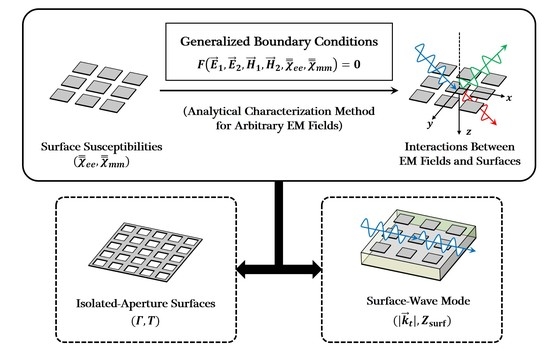Generalized Boundary Conditions in Surface Electromagnetics: Fundamental Theorems and Surface Characterizations
Abstract
:1. Introduction
- 3D EM problems. For structures with , and all comparable to wavelength , they are usually discussed with three-dimensional electromagnetics, which is analyzed by general EM theory. For 3D problems, permittivity and permeability are utilized to characterize properties of homogeneous mediums while their effective counterparts are defined for inhomogeneous ones. The corresponding mathematical tools are derived from Maxwell’s equations.
- 0D EM problems. In contrast, if all dimensions are much smaller than , problems can be addressed with the zero dimension approach through description by lumped parameters. As a result, these problems can be analyzed with circuit theory. For 0D problems, structures can be represented by lumped circuit parameters, such as resistance R, inductance L and capacitance C. Field relations are consistent with Kirchhoff’s laws.
- 1D EM problems. If transverse dimensions and are much smaller than , these one-dimensional problems can be solved with transmission line theory. For 1D problems, the characteristic impedance and propagation constant are the principal parameters which comply with transmission line equations [10].
- 2D EM problems. When only the longitudinal dimension becomes much smaller than , characterization of these two-dimensional surfaces can be denominated as theory of surface electromagnetics (SEM). For 2D problems, the most appropriate characterization parameters are effective surface susceptibilities and [11], while related mathematical models are named as generalized boundary conditions (GBCs).
2. Classification of Electromagnetic Surfaces
2.1. Homogeneous Effective and Spatially Dispersive
2.2. Isolated Scatterers and Isolated Apertures
2.3. Isotropic and Anisotropic
2.4. Single-Layer and Multiple-Layer
2.5. Space Wave and Surface Wave Features
2.6. Summary
3. Boundary Conditions and Scattering Properties of Two-Dimensional Surfaces
3.1. Evolution of Boundary Conditions
- If the tangential electric fields are continuous across surfaces, the surface magnetic current becomes zero according to Equation (2). As a result, the magnetic impedance is equal to zero and the bridged-T circuit model can be simplified into a shunt impedance shown in Figure 10b. A specific example is surfaces composed of zero-thickness scatterers made of perfect electric conductor (PEC).
- If the tangential magnetic fields are continuous, then the surface electric current is equal to zero based on Equation (1). Consequently, the electric impedance would become infinity and the circuit model is simplified as a series impedance shown in Figure 10c. Surfaces made of zero-thickness perfect magnetic conductor (PMC) can be characterized by this model.
3.2. Scattering Properties of Two-Dimensional Surfaces
3.3. Relations between Scattering Properties and Sheet Impedances
3.4. Relations between Scattering Properties and Surface Susceptibilities
3.5. Relations between Sheet Impedances and Surface Susceptibilities
4. Surface Characterizations Based on Surface Susceptibilities
4.1. Extraction of Surface Susceptibilities
- one simulation of normal incidence with = to obtain and ;
- one simulation of TE-polarized oblique incidence with = to obtain and ;
- one simulation of TM-polarized oblique incidence with = to obtain and .
4.2. Surface Characterization Procedure
- carry out three sets of unit cell simulations of given surfaces, including = and = for both TE and TM polarizations;
- extract and from simulated scattering coefficients through Equation (32);
- compute for arbitrary and polarizations using Equations (21) and (22).
4.3. Example of Surface Characterizations Based on Surface Susceptibilities
5. Characterization of Isolated-Aperture Surfaces
5.1. Babinet’s Principle
- in free space;
- there is an infinitely large planar zero-thickness PEC screen having an aperture with arbitrary shape, which is located at z = 0 plane;
- there is a zero-thickness plate made of PMC located at z = 0 plane, whose shape and position is exactly same as the aperture in the last problem.
5.2. Scattering Coefficients of Metascreens and Surface Susceptibilities of Complementary Metafilms
- one simulation of normal incidence with = to obtain ;
- one simulation of TM-polarized oblique incidence with = to obtain .
- carry out two sets of unit cell simulations of given metascreens, including = and = for only TM polarization;
- extract and from simulated scattering coefficients through Equation (39);
5.3. Example of Metascreen Characterizations
6. Characterization of Surface Wave Modes
6.1. Characterization Parameters of Surface-Wave Mode
6.2. Equivalent Circuit Model and Transverse Resonance Method
- carry out limited sets of space-wave simulations of the top-layer surface and extract its surface susceptibilities from simulated scattering coefficients;
- determine the expression of based on and through related formulas derived in previous sections;
- substitute into Equation (53) and solve the equation of with numerical tools.
6.3. Example of Surface-Wave Mode Characterization
7. Conclusions
Author Contributions
Funding
Conflicts of Interest
References
- Mittra, R.; Chan, C.H.; Cwik, T. Techniques for Analyzing Frequency Selective Surfaces-A Review. Proc. IEEE 1988, 76, 1593–1615. [Google Scholar] [CrossRef]
- Wu, T.K. Frequency Selective Surface and Grid Array; Wiley-Interscience: Hoboken, NJ, USA, 1995; Volume 40. [Google Scholar]
- Munk, B. Frequency Selective Surfaces: Theory and Design; John Wiley & Sons: Hoboken, NJ, USA, 2005. [Google Scholar]
- Sievenpiper, D.; Lijun, Z.; Broas, R.F.J.; Alexopolous, N.G.; Yablonovitch, E. High-Impedance Electromagnetic Surfaces with a Forbidden Frequency Band. IEEE Trans. Microw. Theory Tech. 1999, 47, 2059–2074. [Google Scholar] [CrossRef]
- Yang, F.; Rahmat-Samii, Y. Microstrip Antennas Integrated with Electromagnetic Band-Gap (EBG) Structures: A Low Mutual Coupling Design for Array Applications. IEEE Trans. Antennas Propag. 2003, 51, 2936–2946. [Google Scholar] [CrossRef]
- Yang, F.; Rahmat-Samii, Y. Electromagnetic Band Gap Structures in Antenna Engineering; Cambridge University Press: Cambridge, UK, 2009. [Google Scholar]
- Holloway, C.L.; Kuester, E.F.; Gordon, J.A.; Hara, J.O.; Booth, J.; Smith, D.R. An Overview of the Theory and Applications of Metasurfaces: The Two-Dimensional Equivalents of Metamaterials. IEEE Antennas Propag. Mag. 2012, 54, 10–35. [Google Scholar] [CrossRef]
- Kildishev, A.V.; Boltasseva, A.; Shalaev, V.M. Planar Photonics with Metasurfaces. Science 2013, 339. [Google Scholar] [CrossRef]
- Lin, D.; Fan, P.; Hasman, E.; Brongersma, M.L. Dielectric Gradient Metasurface Optical Elements. Science 2014, 345, 298–302. [Google Scholar] [CrossRef]
- Pozar, D.M. Microwave Engineering; John Wiley & Sons: Hoboken, NJ, USA, 2009. [Google Scholar]
- Holloway, C.L.; Kuester, E.F.; Dienstfrey, A. Characterizing Metasurfaces/Metafilms: The Connection Between Surface Susceptibilities and Effective Material Properties. IEEE Antennas Wirel. Propag. Lett. 2011, 10, 1507–1511. [Google Scholar] [CrossRef]
- Idemen, M.M. Discontinuities in the Electromagnetic Field; John Wiley & Sons: Hoboken, NJ, USA, 2011; Volume 40. [Google Scholar]
- Yu, N.; Genevet, P.; Kats, M.A.; Aieta, F.; Tetienne, J.P.; Capasso, F.; Gaburro, Z. Light Propagation with Phase Discontinuities: Generalized Laws of Reflection and Refraction. Science 2011, 334, 333. [Google Scholar] [CrossRef]
- Selvanayagam, M.; Eleftheriades, G.V. Discontinuous Electromagnetic Fields Using Orthogonal Electric and Magnetic Currents for Wavefront Manipulation. Opt. Expr. 2013, 21, 14409–14429. [Google Scholar] [CrossRef] [PubMed]
- Senior, T.B.A. Impedance Boundary Conditions for Imperfectly Conducting Surfaces. Appl. Sci. Res. Sect. B 1960, 8, 418. [Google Scholar] [CrossRef]
- Hoppe, D.J.; Rahmat-Samii, Y. Impedance Boundary Conditions in Electromagnetics; CRC Press: Boca Raton, FL, USA, 1995. [Google Scholar]
- Tretyakov, S. Analytical Modeling in Applied Electromagnetics; Artech House: Norwood, MA, USA, 2003. [Google Scholar]
- Kuester, E.F.; Mohamed, M.A.; Piket-May, M.; Holloway, C.L. Averaged Transition Conditions for Electromagnetic Fields at a Metafilm. IEEE Trans. Antennas Propag. 2003, 51, 2641–2651. [Google Scholar] [CrossRef]
- Lindell, I.V.; Sihvola, A. Electromagnetic Boundaries with PEC/PMC Equivalence. Prog. Electromagn. Res. Lett. 2016, 61, 119–123. [Google Scholar] [CrossRef]
- Lindell, I.V.; Sihvola, A. Electromagnetic Wave Reflection From Boundaries Defined by General Linear and Local Conditions. IEEE Trans. Antennas Propag. 2017, 65, 4656–4663. [Google Scholar] [CrossRef]
- Holloway, C.L.; Mohamed, M.A.; Kuester, E.F.; Dienstfrey, A. Reflection and Transmission Properties of a Metafilm: With an Application to a Controllable Surface Composed of Resonant Particles. IEEE Trans. Electromagn. Compat. 2005, 47, 853–865. [Google Scholar] [CrossRef]
- Balanis, C.A. Advanced Engineering Electromagnetics; John Wiley & Sons: Hoboken, NJ, USA, 2012. [Google Scholar]
- Abdelrahman, A.H.; Elsherbeni, A.Z.; Yang, F. Transmission Phase Limit of Multilayer Frequency-Selective Surfaces for Transmitarray Designs. IEEE Trans. Antennas Propag. 2014, 62, 690–697. [Google Scholar] [CrossRef]
- Liu, X.; Yang, F.; Li, M.; Xu, S. Analysis of Reflectarray Antenna Elements under Arbitrary Incident Angles and Polarizations Using Generalized Boundary Conditions. IEEE Antennas Wirel. Propag. Lett. 2018, 17, 2208–2212. [Google Scholar] [CrossRef]
- Maci, S.; Minatti, G.; Casaletti, M.; Bosiljevac, M. Metasurfing: Addressing Waves on Impenetrable Metasurfaces. IEEE Antennas Wirel. Propag. Lett. 2011, 10, 1499–1502. [Google Scholar] [CrossRef]
- Nayeri, P.; Yang, F.; Elsherbeni, A.Z. Reflectarray Antennas: Theory, Designs, and Applications; John Wiley & Sons: Hoboken, NJ, USA, 2018. [Google Scholar]
- Holloway, C.L.; Love, D.C.; Kuester, E.F.; Gordon, J.A.; Hill, D.A. Use of Generalized Sheet Transition Conditions to Model Guided Waves on Metasurfaces/Metafilms. IEEE Trans. Antennas Propag. 2012, 60, 5173–5186. [Google Scholar] [CrossRef]
- Capolino, F.; Vallecchi, A.; Albani, M. Equivalent Transmission Line Model with a Lumped X-Circuit for a Metalayer Made of Pairs of Planar Conductors. IEEE Trans. Antennas Propag. 2013, 61, 852–861. [Google Scholar] [CrossRef]
- Selvanayagam, M.; Eleftheriades, G.V. Circuit Modeling of Huygens Surfaces. IEEE Antennas Wirel. Propag. Lett. 2013, 12, 1642–1645. [Google Scholar] [CrossRef]
- Lindell, I.V.; Sihvola, A.H. Perfect Electromagnetic Conductor. J. Electromagn. Waves Appl. 2005, 19, 861–869. [Google Scholar] [CrossRef] [Green Version]
- Achouri, K.; Salem, M.A.; Caloz, C. General Metasurface Synthesis Based on Susceptibility Tensors. IEEE Trans. Antennas Propag. 2015, 63, 2977–2991. [Google Scholar] [CrossRef]
- Holloway, C.L.; Kuester, E.F.; Novotny, D. Waveguides Composed of Metafilms/Metasurfaces: The Two-Dimensional Equivalent of Metamaterials. IEEE Antennas Wirel. Propag. Lett. 2009, 8, 525–529. [Google Scholar] [CrossRef]
- Vahabzadeh, Y.; Achouri, K.; Caloz, C. Simulation of Metasurfaces in Finite Difference Techniques. IEEE Trans. Antennas Propag. 2016, 64, 4753–4759. [Google Scholar] [CrossRef] [Green Version]
- Sandeep, S.; Jin, J.M.; Caloz, C. Finite Element Modeling of Metasurfaces with Generalized Sheet Transition Conditions. IEEE Trans. Antennas Propag. 2017. [Google Scholar] [CrossRef]
- Vahabzadeh, Y.; Chamanara, N.; Caloz, C. Generalized Sheet Transition Condition FDTD Simulation of Metasurface. IEEE Trans. Antennas Propag. 2018, 66, 271–280. [Google Scholar] [CrossRef] [Green Version]
- Holloway, C.L.; Kuester, E.F. Generalized Sheet Transition Conditions for a Metascreen—A Fishnet Metasurface. IEEE Trans. Antennas Propag. 2018, 66, 2414–2427. [Google Scholar] [CrossRef] [Green Version]
- Born, M.; Wolf, E. Principles of Optics: Electromagnetic Theory of Propagation, Interference and Diffaction of Light; Pergamon Press: Oxford, UK, 1959. [Google Scholar]
- Harrington, R.F. Time-Harmonic Electromagnetic Fields; McGraw-Hill: New York, NY, USA, 1961. [Google Scholar]
- Patel, A.M.; Grbic, A. A Printed Leaky-Wave Antenna Based on a Sinusoidally-Modulated Reactance Surface. IEEE Trans. Antennas Propag. 2011, 59, 2087–2096. [Google Scholar] [CrossRef]
- Minatti, G.; Faenzi, M.; Martini, E.; Caminita, F.; Vita, P.D.; González-Ovejero, D.; Sabbadini, M.; Maci, S. Modulated Metasurface Antennas for Space: Synthesis, Analysis and Realizations. IEEE Trans. Antennas Propag. 2015, 63, 1288–1300. [Google Scholar] [CrossRef]
- Minatti, G.; Caminita, F.; Martini, E.; Sabbadini, M.; Maci, S. Synthesis of Modulated-Metasurface Antennas With Amplitude, Phase, and Polarization Control. IEEE Trans. Antennas Propag. 2016, 64, 3907–3919. [Google Scholar] [CrossRef]
- Francavilla, M.A.; Martini, E.; Maci, S.; Vecchi, G. On the Numerical Simulation of Metasurfaces With Impedance Boundary Condition Integral Equations. IEEE Trans. Antennas Propag. 2015, 63, 2153–2161. [Google Scholar] [CrossRef]
- Ramo, S.; Whinnery, J.; Van Duzer, T. Fields and Waves in Communication Electronics; Wiley: Hoboken, NJ, USA, 1994. [Google Scholar]
- Fong, B.H.; Colburn, J.S.; Ottusch, J.J.; Visher, J.L.; Sievenpiper, D.F. Scalar and Tensor Holographic Artificial Impedance Surfaces. IEEE Trans. Antennas Propag. 2010, 58, 3212–3221. [Google Scholar] [CrossRef]
- Walter, C. Traveling Wave Antennas; Dover Publications: Mineola, NY, USA, 1970. [Google Scholar]
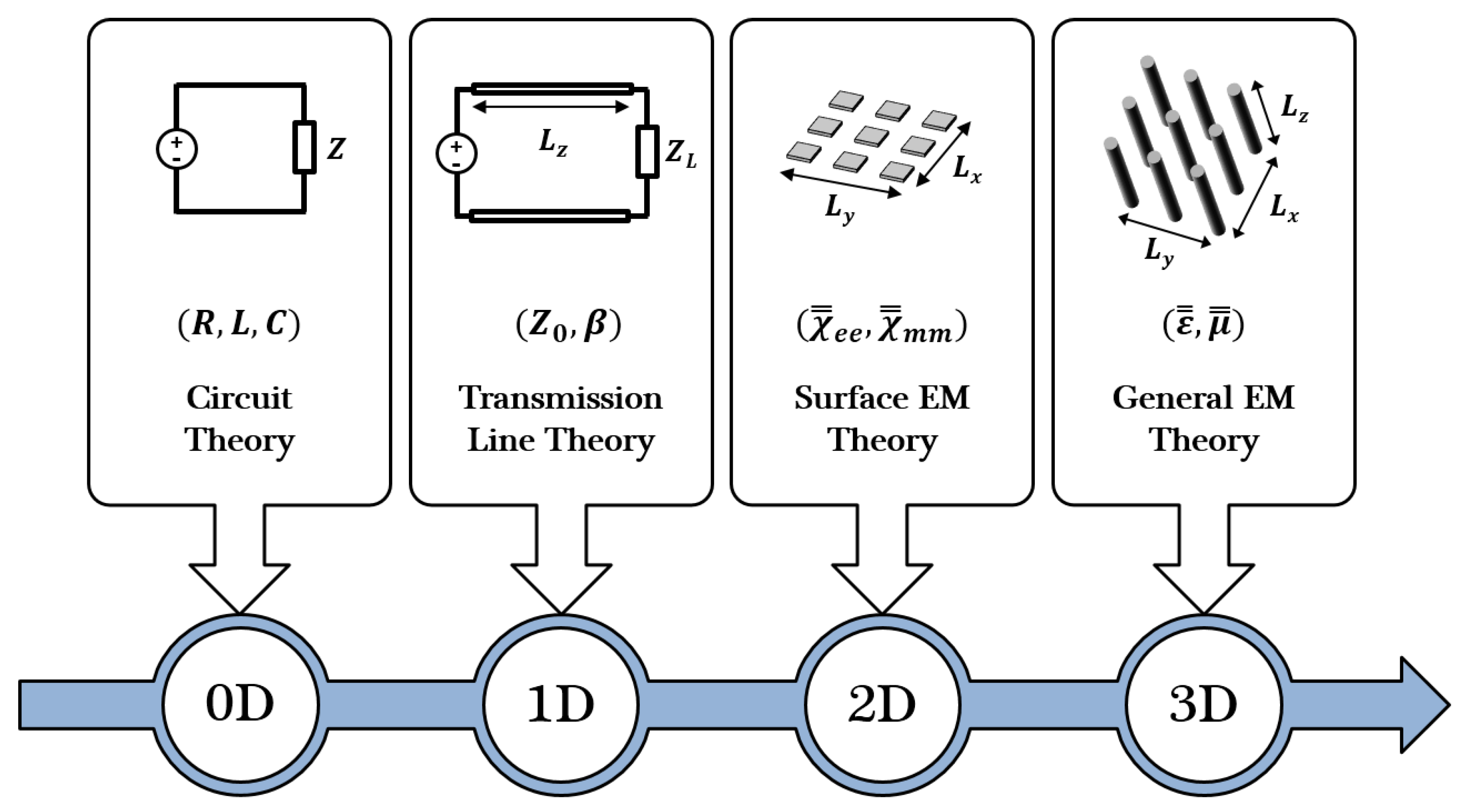
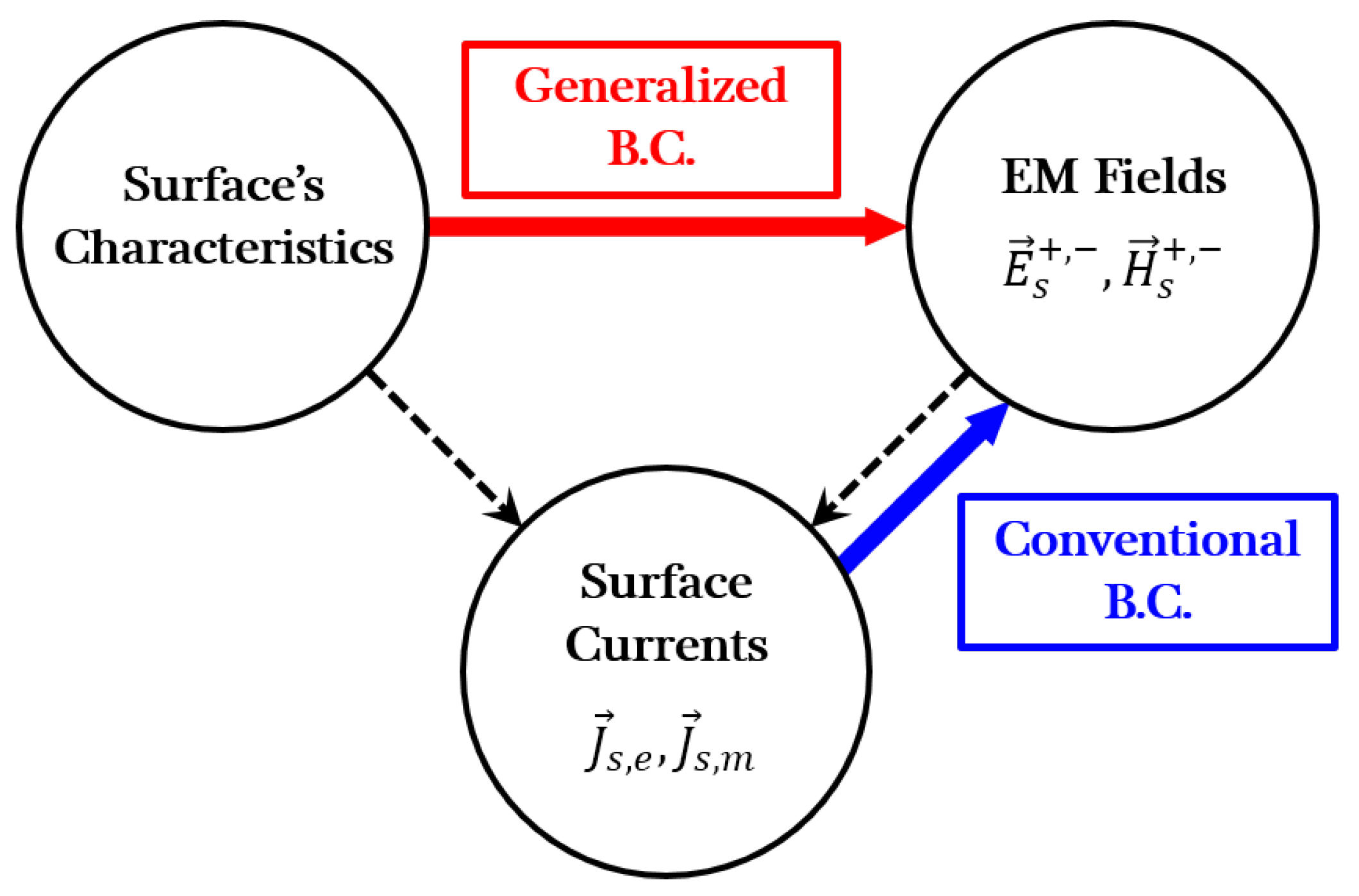
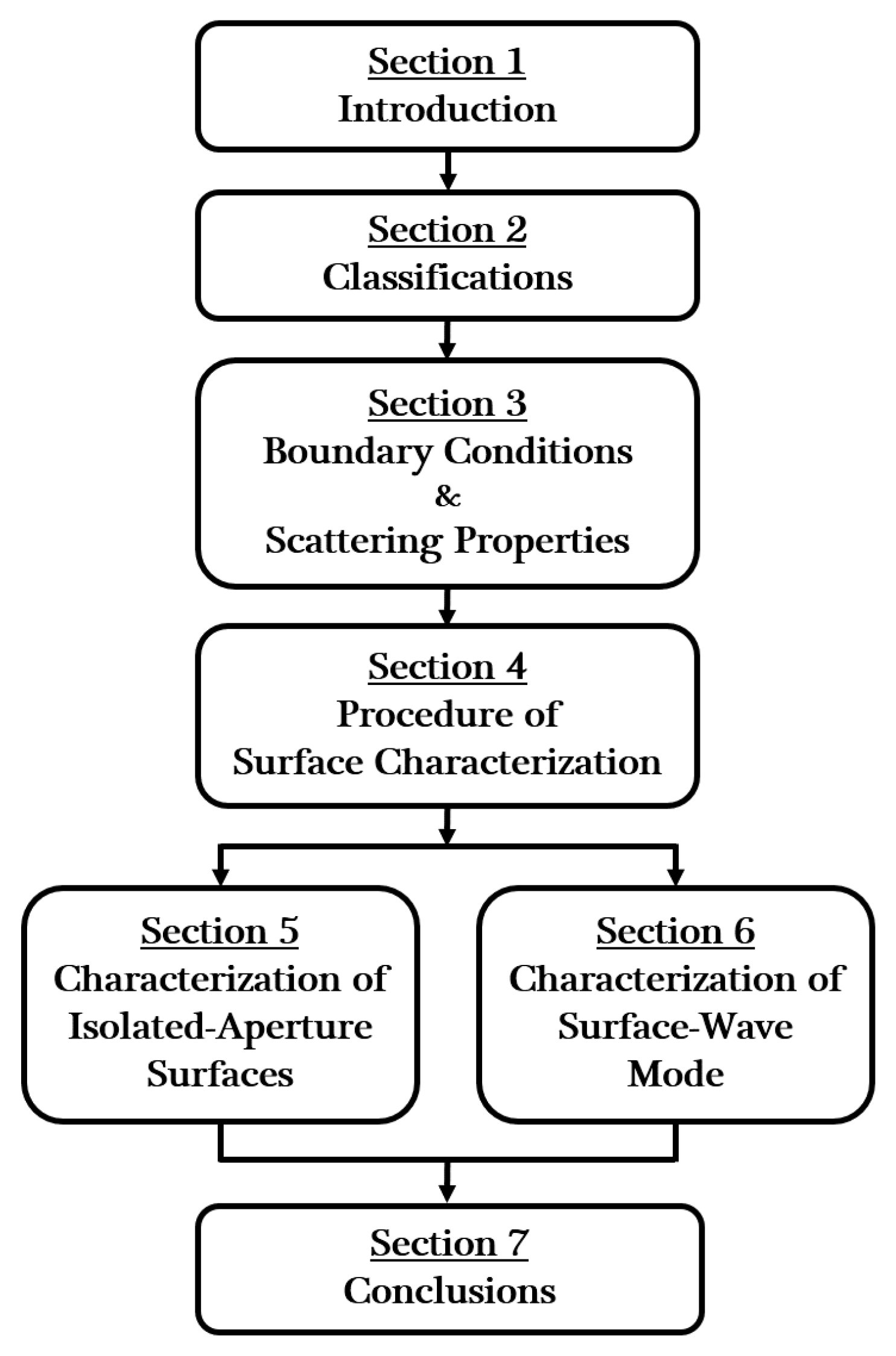



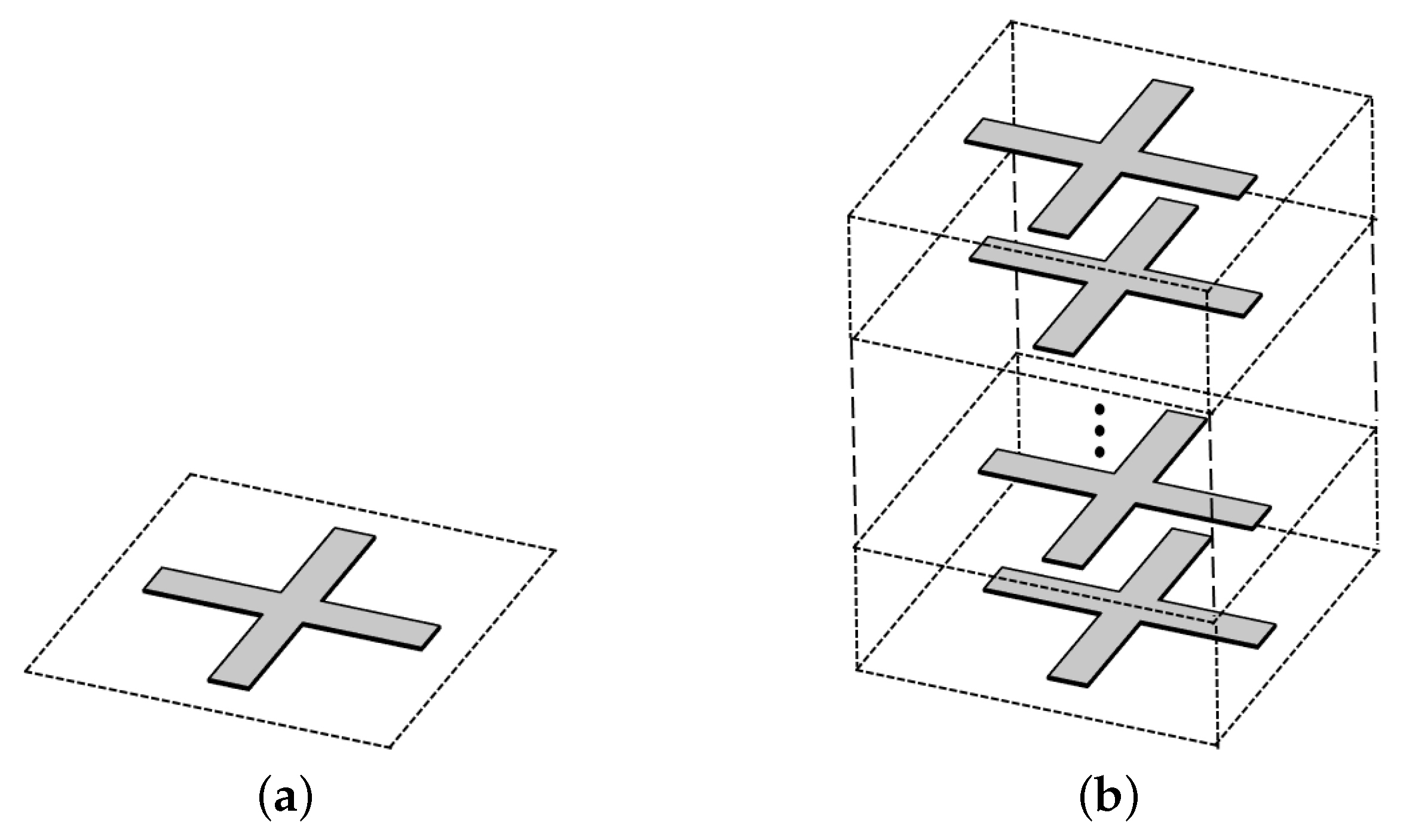
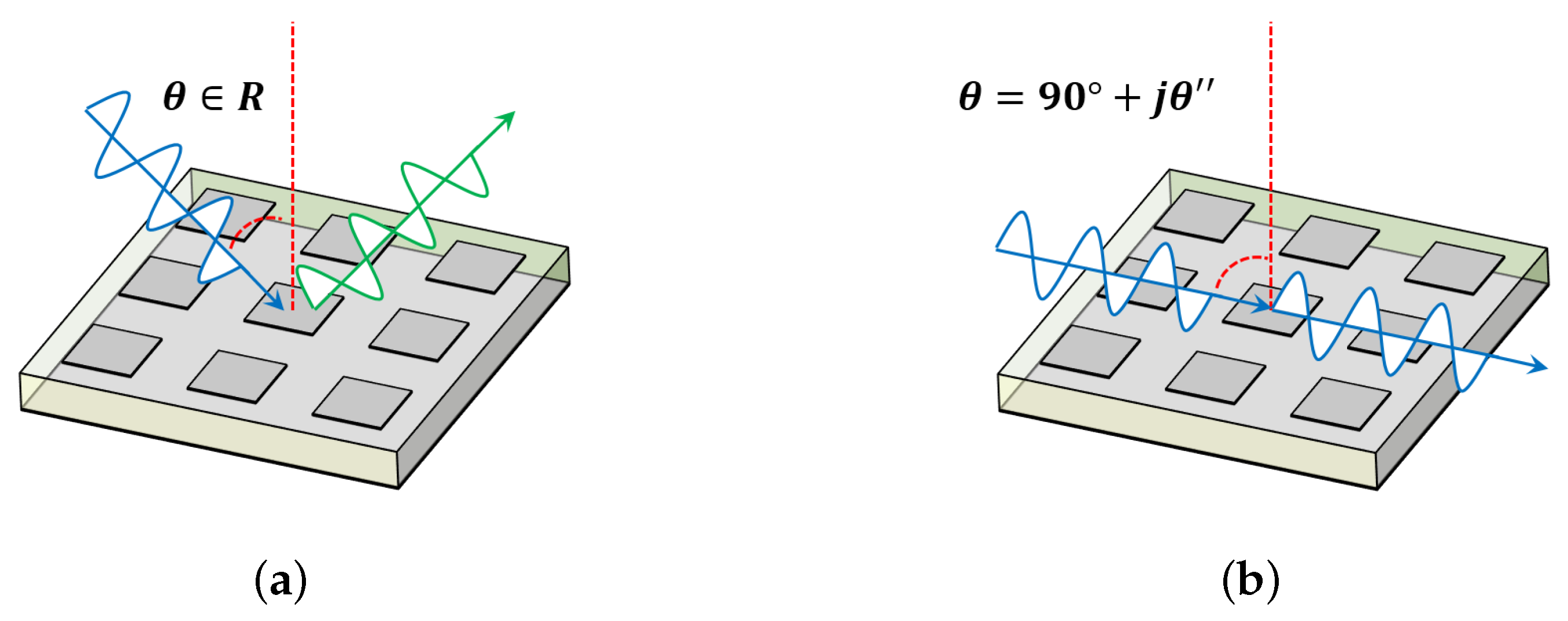
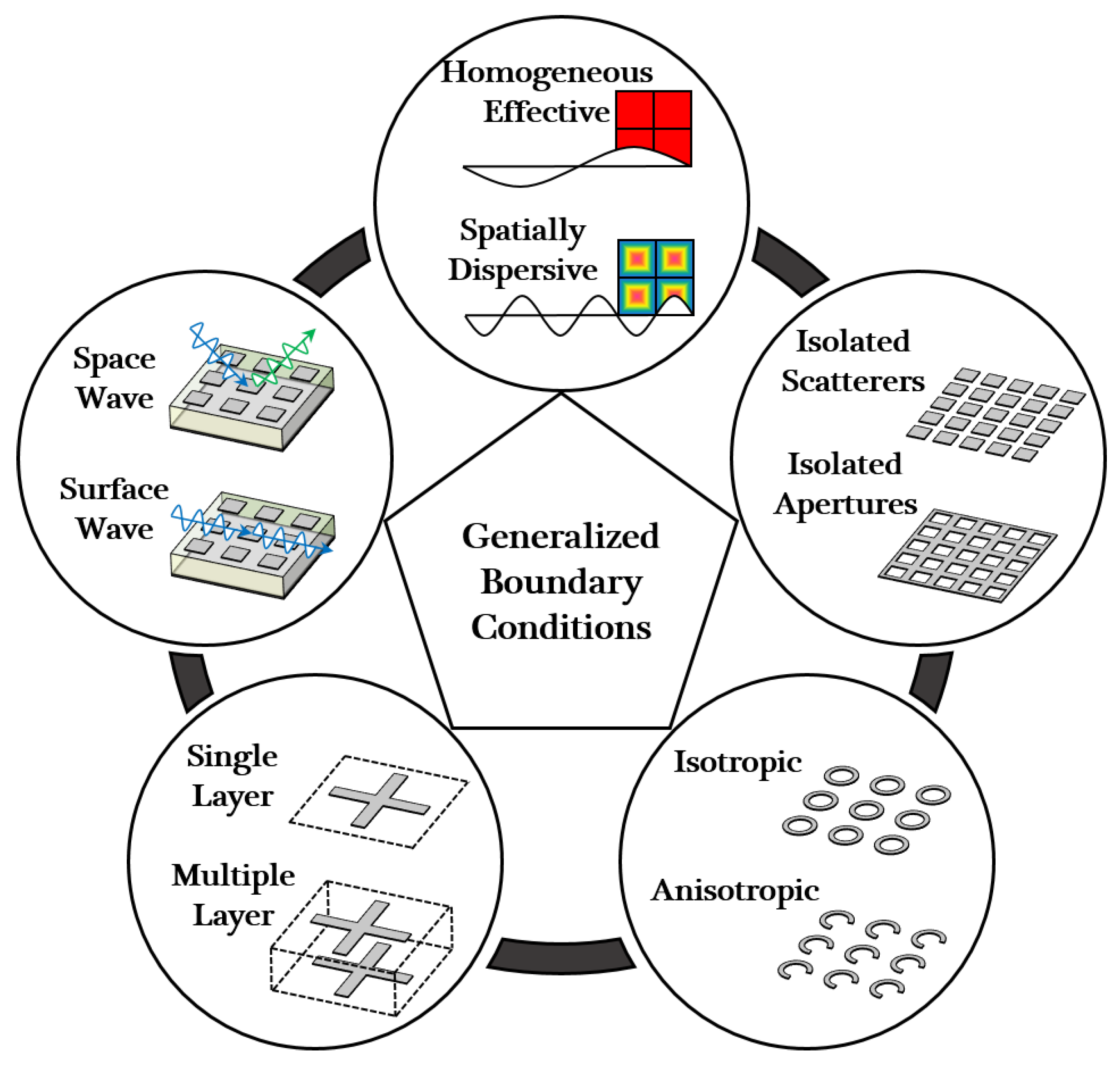



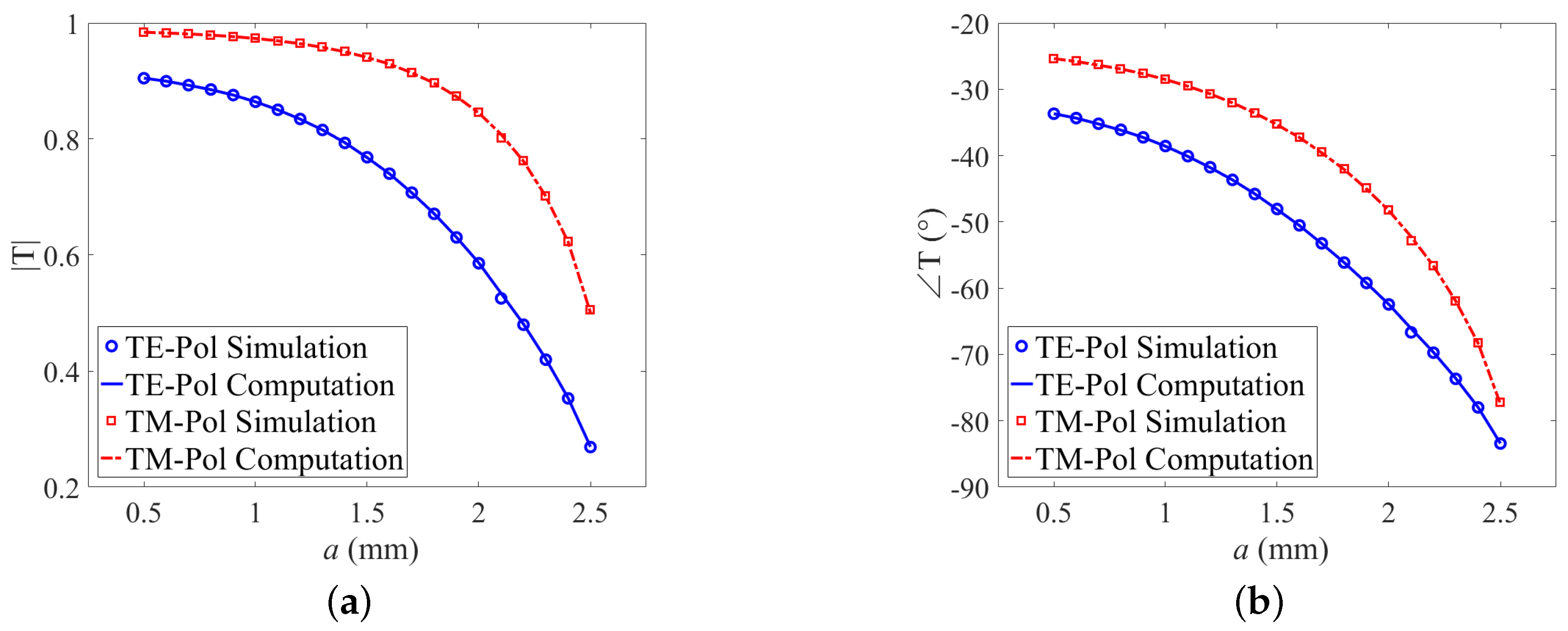

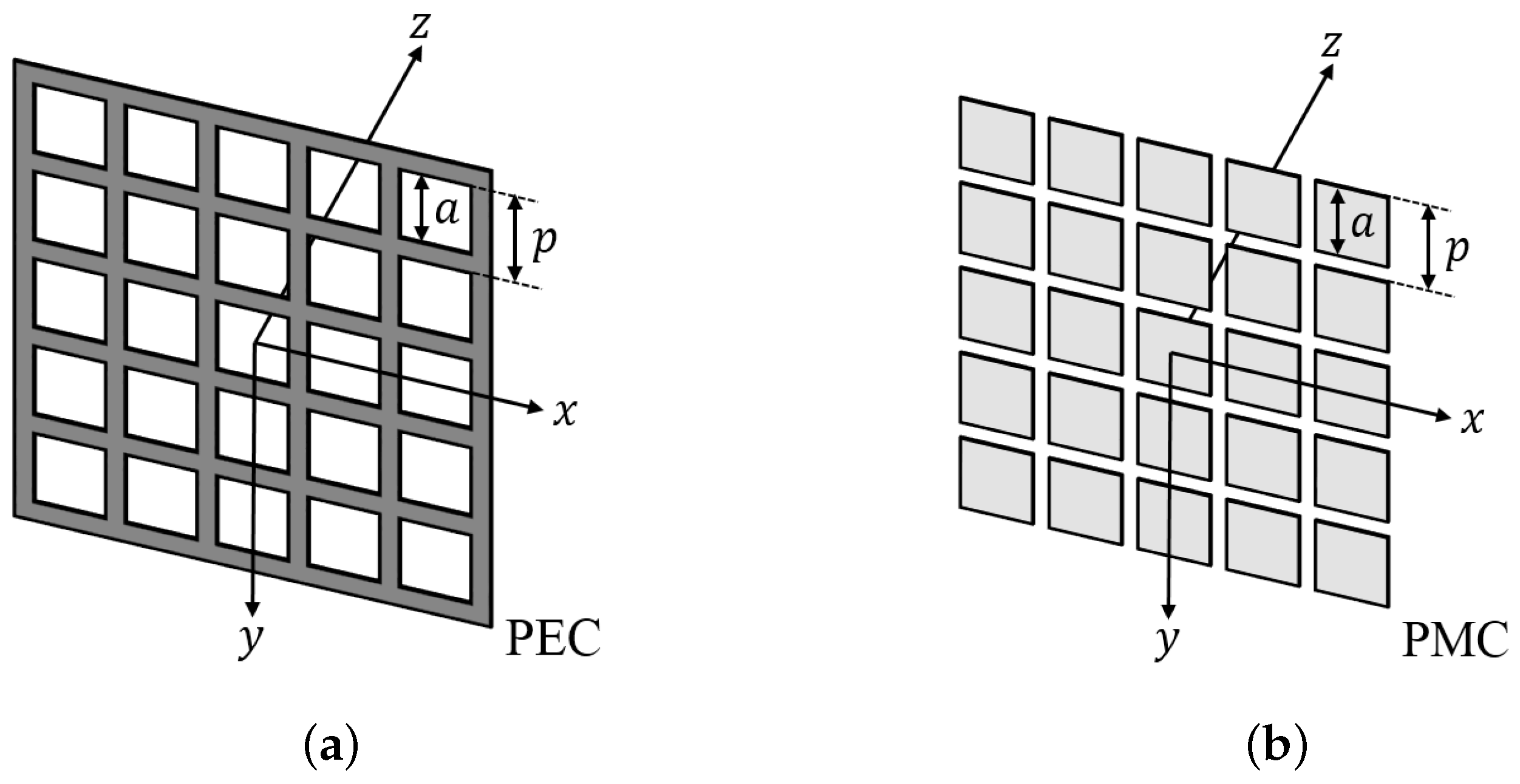
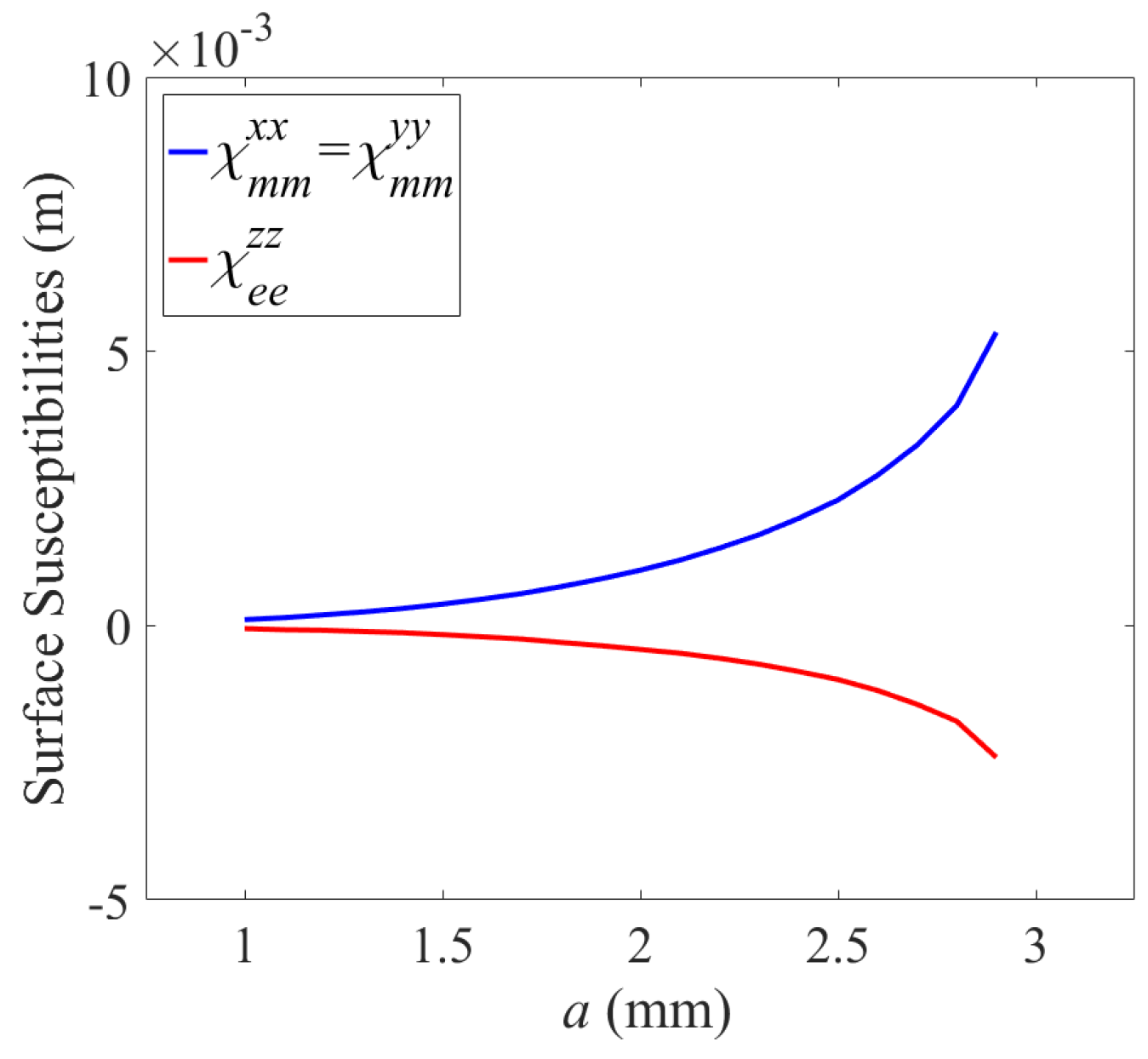

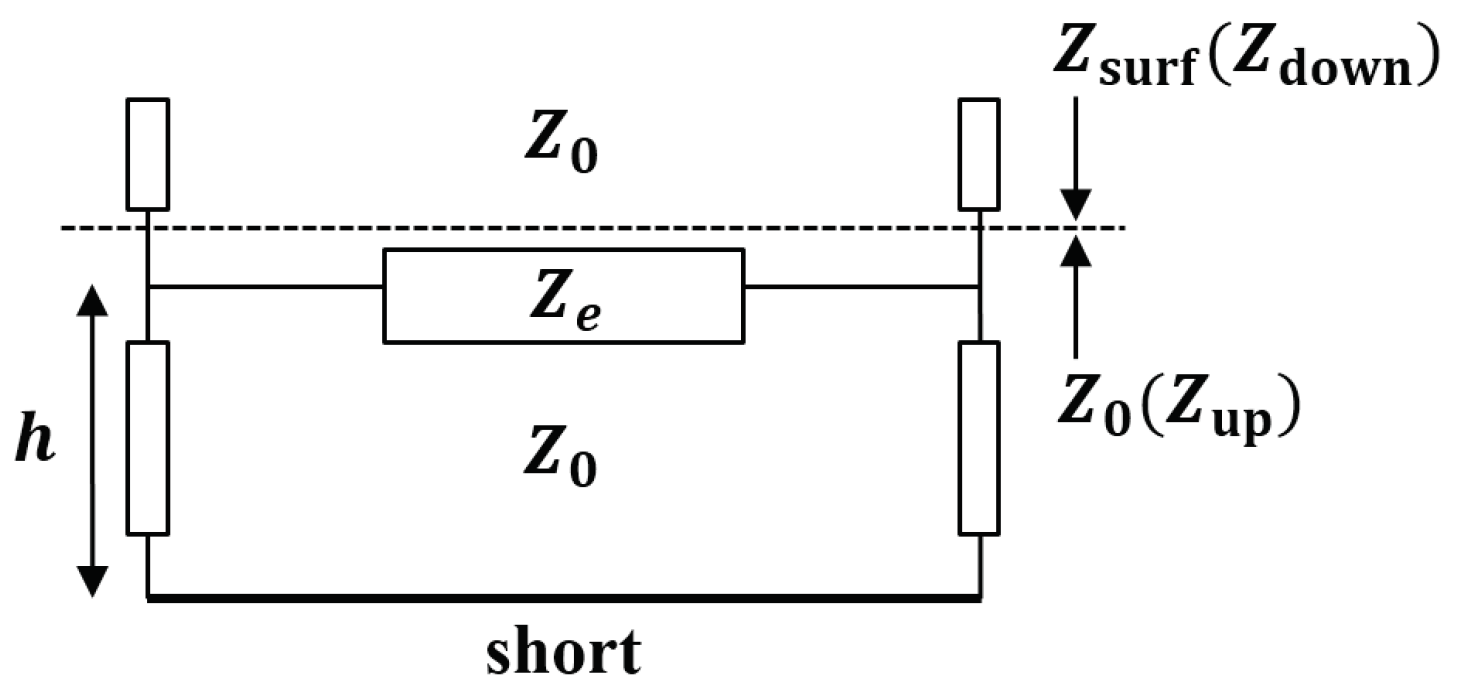


© 2019 by the authors. Licensee MDPI, Basel, Switzerland. This article is an open access article distributed under the terms and conditions of the Creative Commons Attribution (CC BY) license (http://creativecommons.org/licenses/by/4.0/).
Share and Cite
Liu, X.; Yang, F.; Li, M.; Xu, S. Generalized Boundary Conditions in Surface Electromagnetics: Fundamental Theorems and Surface Characterizations. Appl. Sci. 2019, 9, 1891. https://doi.org/10.3390/app9091891
Liu X, Yang F, Li M, Xu S. Generalized Boundary Conditions in Surface Electromagnetics: Fundamental Theorems and Surface Characterizations. Applied Sciences. 2019; 9(9):1891. https://doi.org/10.3390/app9091891
Chicago/Turabian StyleLiu, Xiao, Fan Yang, Maokun Li, and Shenheng Xu. 2019. "Generalized Boundary Conditions in Surface Electromagnetics: Fundamental Theorems and Surface Characterizations" Applied Sciences 9, no. 9: 1891. https://doi.org/10.3390/app9091891
APA StyleLiu, X., Yang, F., Li, M., & Xu, S. (2019). Generalized Boundary Conditions in Surface Electromagnetics: Fundamental Theorems and Surface Characterizations. Applied Sciences, 9(9), 1891. https://doi.org/10.3390/app9091891





